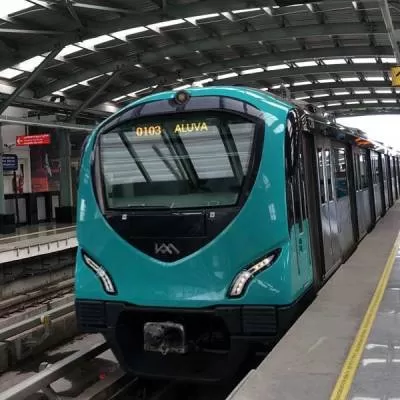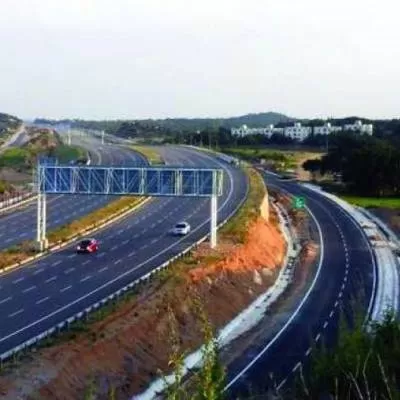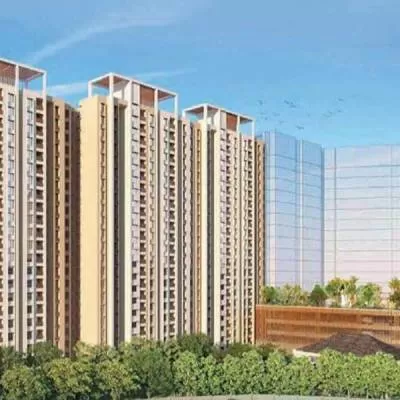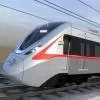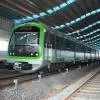- Home
- Real Estate
- The Vertical View
The Vertical View
Engineer Jagvir Goyal tells us about vertical transport equipment for construction sites.
Construction sites often need vertical transport equipment to take men and materials to working levels at different heights. Tall structures like high-rise, multi-storied buildings, chimneys, cooling towers and boilers can’t be built unless a mechanised transport system is created at site. Therefore, thermal power plants, the cement industry, ports, the steel industry, sugar mills, power industry, multi-storied malls and hotels look for the availability of a suitable passenger-cum-material hoists to serve the purpose.
Passenger-cum-material hoist
Thousands of scaffolding pipes are often erected at construction sites, allowing little space to accommodate separate hoists for men and materials. Space constraints pose problems in finding clear vertical routes to run the passenger cages and material buckets or platforms. Therefore, a common hoist for men and materials is often required.
Regular vertical transport equipment produced by most reputed companies like Otis, Krupp, Schneider and Kone is electronically checked and operated, and undergoes hundreds of precision checks and tests before installation. Computer controls, microprocessor controls, countless safety checks and customised designs make this equipment completely safe and comfortably operational. On the other hand, site hoists are temporarily installed, run and dismantled on completion of a structure. They can’t be as expensive as regular lifts and elevators. Therefore, their design is crude compared to sophisticated equipment. This apart, it is still important to look for certain essential features in this equipment such as safety, smooth operation, easy erection and dismantling, and easy control.
Safety features
Special care needs to be taken to ensure safety in passenger-cum-material hoists. Casualness in checking, maintenance and overloading can often cause fatal accidents. Most important among safety features is the provision of limit switches. There should be an upper limit switch and a lower limit switch, each stopping the cage from going up or down beyond certain limits. In addition, there should be a maximum load alarm. Additional limit switches on entering the cage and exiting it are preferred. Another key safety feature is the provision of a fail-safe brake to save the cage from falling under gravity on the failure of the hoist. The cage should have an emergency light that should automatically switch on in case of a power failure. The operating motors should also have magnetic brakes to control the cage in case of a malfunction. In such conditions, the cage can be lowered slowly through manual brake operation to safely bring down the men caught inside. As safety is the most important feature required for construction of site lifts, the following checklist should be consulted:
| No. | Safety feature | Check |
| 1 | Upper limit switch | |
| 2 | Lower limit switch | |
| 3 | Maximum load alarm | |
| 4 | Cage entry limit switch | |
| 5 | Cage exit limit switch | |
| 6 | Fail-safe brake | |
| 7 | Emergency light | |
| 8 | Magnetic brake in motors | |
| 9 | Manual brake | |
| 10 | Cage lock |
Smooth operation
Smooth up and down travel of the cage should be provided by the passenger-cum-material hoist. Smooth operation depends on the type of arrangement used in the machine. A rack and pinion arrangement proves successful on this account. The opinion gear uniformly moves on the rack gear, transmitting its rotational motion to the vertical motion of the rack through the teeth engagement.
Easy erection
Erection of the passenger-cum-material hoist should be fast and easy. As far as possible, a modular system should be utilised. Here, all components have fixed dimensions and fit into each other easily and quickly. The cage rides a mast that is easily erectable and anchored to a structure. Otherwise, a sheave pulley arrangement at the top of the modular formwork is made.
Easy dismantling
An easily erectable passenger-cum-material hoist is easy to dismantle also. The only difference is that dismantling is from top-downwards while erection is from bottom-upwards. A passenger-cum-material hoist is generally the last item to be dismantled as site managers want to keep it available for the maximum amount of time. Therefore, its dismantling should be easy and requiring least accessory equipment.
Easy control
The control panels for the hoist should be easier to understand and operate as many hands operate it. The control panel should provide complete control of the cage to stop it at required heights where materials are to be loaded or unloaded and men are to enter or exit the cage. A variable frequency drive is sometimes provided in the system to ensure a jerk-free ride.
Height capacity
Passenger-cum-material hoists need to reach the maximum possible vertical distance in the structure under construction. Chimneys are often the highest structures to disperse flue gases at higher elevations from the point of view of the environment. These days, the height of chimneys is often 275 m for thermal power projects. Boilers and other structures have a lower height comparatively. Keeping this in view, the hoists should be able to travel to 300 m vertical height. The world’s tallest buildings like Burj Khalifa and Taipei 101 needed supplementary arrangements like tower cranes erected at upper levels to handle materials.
Load capacity
Under normal circumstances, a passenger-cum-material hoist should be able to carry about 1,000 kg. Obviously, the higher the load capacity, the better the hoist facilitates work. However, a hoist with a capacity higher than required does not prove economical. Therefore, the material load and number of people likely to travel together should be checked before installation. In general, hoists with load carrying capacities up to 1,500 kg are readily available with suppliers and used at sites.
Speed of travel
The hoist should have a speed below 1 m per second. A speed of 0.5 m per second is preferred. This is much lower than the speed of regular elevators. The slower the speed of the hoist, the safer it is as many scaffolding pipes and bracings sometimes protrude into the void space suitable to run the passenger cage and material platforms. However, very slow moving hoists hamper the progress of work owing to delayed cycle of transportation of men and material. Therefore, the choice of speed has to be made carefully according to site requirements.
Hoist arrangements
In the standard hoists supplied by manufacturers, a standard sized modular frame of structural steel is fixed to a concrete base created on site at the location of erection of the hoist. A mast is then erected on this structural steel frame and raised up to the required height. The mast is made of fixed length steel tube sections joined to form a square section mast. Each mast piece has equal height, up to 1.5 m. The pieces are joined together through the standard male-female joints as such joints prove safe.
The passenger cage rides this mast to travel up or down and is controlled by upper and lower limit switches. Motors are installed over the cage itself. The capacity of these motors depends on the maximum load to be carried and maximum height to be travelled by the cage. To provide stability, the mast is anchored to the structure at regular height intervals of 2-3 m. For this arrangement, inserts are left in the concrete structure as it progresses upwards and anchorage ropes are tied to the mast and these inserts.
Winch arrangements
An alternative arrangement made on site by construction companies is the use of a double drum winch to run a passenger-cum-material cage up and down, inside the structure. A double drum winch is erected on the foundation created for it, at a safe distance from the outer periphery of the structure under construction. The modular structural steel frame is fixed to the concrete base created inside or outside the structure. It is generally preferred to create this arrangement inside the structure as it is not considered safe and easy to lower the passenger cage in open areas outside the structure. Wire ropes are run from the winch to the passenger cage through sheave pulley arrangements created at the wire rope’s direction change points. Thus, sheave pulleys are provided on the ground, at top and on the top of the passenger cage. Additional guide ropes are provided for the passenger cage in this case as this arrangement is quite rough in comparison to the ready-built site lifts provided by suppliers.
The size of wire ropes used in this case has to be at least 16 mm and preferably 20 mm. The strands need to be checked regularly. Guide ropes can be of 12 mm or 16 mm diameter. As the structure is under construction and sheave pulley arrangement at the top has to be shifted upwards from time to time, manual winches need to be provided to release the guide ropes to match their height with the rising structure. Winches are provided with magnetic brakes to lower the cage slowly in case of power failure.
Site arrangements
While ordering the installation of a site lift, site managers should clearly identify the site arrangements to be provided to lift suppliers. Site arrangements normally include the layout, location and provision of a concrete base for the hoist; necessary power supply arrangements that must be safe and secure and not provided through temporary wiring; switchboards for power supply control; and other enabling works as per site conditions during the course of attraction. In addition, it is preferable to train a couple of people on site in the operation of the hoist and checking it in case of troubleshooting.
Technical features
The following technical features should be worked out mutually between the site engineers and equipment suppliers:
• Maximum height to be travelled
• Maximum and minimum speed of travel
• Vertical spacing of anchorage of modular formwork tower or mast
• Maximum load carrying capacity
• Maximum number of persons that can travel at a time
• Size of passenger cage
• Section, size, weight and height of mast components
• Type of control panel
• Capacity of motors, their make and other features
• Safety features to be incorporated
• Painting specifications
• Operation manuals.
Equipment suppliers
Major elevator suppliers like Otis, Kone, Schneider and Krupp do not supply passenger-cum-material hoists for sites. These hoists or lifts for sites are sometimes devised by the mechanical engineers group of construction companies themselves. However, such lifts are always lacking in one safety feature or the other and are risky to use and often suffer jerks during operation. Thus, the provision of site lifts or hoists should be entirely left to equipment suppliers as they work hard on making these lifts safe and trouble-free. Among Indian suppliers, Universal has supplied many such lifts to different construction sites. Other Indian passenger-cum-material hoist suppliers include Acme, Asian, Avon, Spartan, Globe and Techno Engineers.
Burj Khalifa: Taller than all
For the construction of the 828-m Burj Khalifa, the tallest building on earth, the passenger-cum-material hoists were specially developed to handle the countless number of workers at different decks and levels and to transport tonnes of materials of different nature. The capacity of the hoists was 3,200 kg instead of the normal capacity of 1,000-1,200 kg. The speed of travel was 2 m per second-very high compared to the normal 0.5 m per second.
Quick Bytes
• The most important among safety features in passengercum-material hoists is the provision of limit switches.
• For a smooth operation, a rack and pinion arrangement proves successful.
• The hoist should have a speed below 1 m per second.
• Hoists with load carrying capacities up to 1,500 kg are readily available with suppliers and used at sites.
- Construction
- Update
- Portal
- Magazine
- India
- August
- 2010
- World
- vertical
- transport
- equipment
- sites
- Tall
- structures
- thermal
- power
- cement
- steel
- chimneys
- scaffolding
- pipes
- Otis
- Krupp
- Schneider
- Kone
- microprocessor
- safety
- erection
- dismantling
- cage
- modular
- Burj Khalifa
- Taipei
- troubleshooting
- Acme
- Asian
- Avon
- Spartan
Engineer Jagvir Goyal tells us about vertical transport equipment for construction sites. Construction sites often need vertical transport equipment to take men and materials to working levels at different heights. Tall structures like high-rise, multi-storied buildings, chimneys, cooling towers and boilers can’t be built unless a mechanised transport system is created at site. Therefore, thermal power plants, the cement industry, ports, the steel industry, sugar mills, power industry, multi-storied malls and hotels look for the availability of a suitable passenger-cum-material hoists to serve the purpose. Passenger-cum-material hoist Thousands of scaffolding pipes are often erected at construction sites, allowing little space to accommodate separate hoists for men and materials. Space constraints pose problems in finding clear vertical routes to run the passenger cages and material buckets or platforms. Therefore, a common hoist for men and materials is often required. Regular vertical transport equipment produced by most reputed companies like Otis, Krupp, Schneider and Kone is electronically checked and operated, and undergoes hundreds of precision checks and tests before installation. Computer controls, microprocessor controls, countless safety checks and customised designs make this equipment completely safe and comfortably operational. On the other hand, site hoists are temporarily installed, run and dismantled on completion of a structure. They can’t be as expensive as regular lifts and elevators. Therefore, their design is crude compared to sophisticated equipment. This apart, it is still important to look for certain essential features in this equipment such as safety, smooth operation, easy erection and dismantling, and easy control. Safety features Special care needs to be taken to ensure safety in passenger-cum-material hoists. Casualness in checking, maintenance and overloading can often cause fatal accidents. Most important among safety features is the provision of limit switches. There should be an upper limit switch and a lower limit switch, each stopping the cage from going up or down beyond certain limits. In addition, there should be a maximum load alarm. Additional limit switches on entering the cage and exiting it are preferred. Another key safety feature is the provision of a fail-safe brake to save the cage from falling under gravity on the failure of the hoist. The cage should have an emergency light that should automatically switch on in case of a power failure. The operating motors should also have magnetic brakes to control the cage in case of a malfunction. In such conditions, the cage can be lowered slowly through manual brake operation to safely bring down the men caught inside. As safety is the most important feature required for construction of site lifts, the following checklist should be consulted: No. Safety feature Check 1 Upper limit switch 2 Lower limit switch 3 Maximum load alarm 4 Cage entry limit switch 5 Cage exit limit switch 6 Fail-safe brake 7 Emergency light 8 Magnetic brake in motors 9 Manual brake 10 Cage lock Smooth operation Smooth up and down travel of the cage should be provided by the passenger-cum-material hoist. Smooth operation depends on the type of arrangement used in the machine. A rack and pinion arrangement proves successful on this account. The opinion gear uniformly moves on the rack gear, transmitting its rotational motion to the vertical motion of the rack through the teeth engagement. Easy erection Erection of the passenger-cum-material hoist should be fast and easy. As far as possible, a modular system should be utilised. Here, all components have fixed dimensions and fit into each other easily and quickly. The cage rides a mast that is easily erectable and anchored to a structure. Otherwise, a sheave pulley arrangement at the top of the modular formwork is made. Easy dismantling An easily erectable passenger-cum-material hoist is easy to dismantle also. The only difference is that dismantling is from top-downwards while erection is from bottom-upwards. A passenger-cum-material hoist is generally the last item to be dismantled as site managers want to keep it available for the maximum amount of time. Therefore, its dismantling should be easy and requiring least accessory equipment. Easy control The control panels for the hoist should be easier to understand and operate as many hands operate it. The control panel should provide complete control of the cage to stop it at required heights where materials are to be loaded or unloaded and men are to enter or exit the cage. A variable frequency drive is sometimes provided in the system to ensure a jerk-free ride. Height capacity Passenger-cum-material hoists need to reach the maximum possible vertical distance in the structure under construction. Chimneys are often the highest structures to disperse flue gases at higher elevations from the point of view of the environment. These days, the height of chimneys is often 275 m for thermal power projects. Boilers and other structures have a lower height comparatively. Keeping this in view, the hoists should be able to travel to 300 m vertical height. The world’s tallest buildings like Burj Khalifa and Taipei 101 needed supplementary arrangements like tower cranes erected at upper levels to handle materials. Load capacity Under normal circumstances, a passenger-cum-material hoist should be able to carry about 1,000 kg. Obviously, the higher the load capacity, the better the hoist facilitates work. However, a hoist with a capacity higher than required does not prove economical. Therefore, the material load and number of people likely to travel together should be checked before installation. In general, hoists with load carrying capacities up to 1,500 kg are readily available with suppliers and used at sites. Speed of travel The hoist should have a speed below 1 m per second. A speed of 0.5 m per second is preferred. This is much lower than the speed of regular elevators. The slower the speed of the hoist, the safer it is as many scaffolding pipes and bracings sometimes protrude into the void space suitable to run the passenger cage and material platforms. However, very slow moving hoists hamper the progress of work owing to delayed cycle of transportation of men and material. Therefore, the choice of speed has to be made carefully according to site requirements. Hoist arrangements In the standard hoists supplied by manufacturers, a standard sized modular frame of structural steel is fixed to a concrete base created on site at the location of erection of the hoist. A mast is then erected on this structural steel frame and raised up to the required height. The mast is made of fixed length steel tube sections joined to form a square section mast. Each mast piece has equal height, up to 1.5 m. The pieces are joined together through the standard male-female joints as such joints prove safe. The passenger cage rides this mast to travel up or down and is controlled by upper and lower limit switches. Motors are installed over the cage itself. The capacity of these motors depends on the maximum load to be carried and maximum height to be travelled by the cage. To provide stability, the mast is anchored to the structure at regular height intervals of 2-3 m. For this arrangement, inserts are left in the concrete structure as it progresses upwards and anchorage ropes are tied to the mast and these inserts. Winch arrangements An alternative arrangement made on site by construction companies is the use of a double drum winch to run a passenger-cum-material cage up and down, inside the structure. A double drum winch is erected on the foundation created for it, at a safe distance from the outer periphery of the structure under construction. The modular structural steel frame is fixed to the concrete base created inside or outside the structure. It is generally preferred to create this arrangement inside the structure as it is not considered safe and easy to lower the passenger cage in open areas outside the structure. Wire ropes are run from the winch to the passenger cage through sheave pulley arrangements created at the wire rope’s direction change points. Thus, sheave pulleys are provided on the ground, at top and on the top of the passenger cage. Additional guide ropes are provided for the passenger cage in this case as this arrangement is quite rough in comparison to the ready-built site lifts provided by suppliers. The size of wire ropes used in this case has to be at least 16 mm and preferably 20 mm. The strands need to be checked regularly. Guide ropes can be of 12 mm or 16 mm diameter. As the structure is under construction and sheave pulley arrangement at the top has to be shifted upwards from time to time, manual winches need to be provided to release the guide ropes to match their height with the rising structure. Winches are provided with magnetic brakes to lower the cage slowly in case of power failure. Site arrangements While ordering the installation of a site lift, site managers should clearly identify the site arrangements to be provided to lift suppliers. Site arrangements normally include the layout, location and provision of a concrete base for the hoist; necessary power supply arrangements that must be safe and secure and not provided through temporary wiring; switchboards for power supply control; and other enabling works as per site conditions during the course of attraction. In addition, it is preferable to train a couple of people on site in the operation of the hoist and checking it in case of troubleshooting. Technical features The following technical features should be worked out mutually between the site engineers and equipment suppliers: • Maximum height to be travelled• Maximum and minimum speed of travel• Vertical spacing of anchorage of modular formwork tower or mast• Maximum load carrying capacity• Maximum number of persons that can travel at a time• Size of passenger cage• Section, size, weight and height of mast components• Type of control panel• Capacity of motors, their make and other features• Safety features to be incorporated• Painting specifications• Operation manuals. Equipment suppliers Major elevator suppliers like Otis, Kone, Schneider and Krupp do not supply passenger-cum-material hoists for sites. These hoists or lifts for sites are sometimes devised by the mechanical engineers group of construction companies themselves. However, such lifts are always lacking in one safety feature or the other and are risky to use and often suffer jerks during operation. Thus, the provision of site lifts or hoists should be entirely left to equipment suppliers as they work hard on making these lifts safe and trouble-free. Among Indian suppliers, Universal has supplied many such lifts to different construction sites. Other Indian passenger-cum-material hoist suppliers include Acme, Asian, Avon, Spartan, Globe and Techno Engineers. Burj Khalifa: Taller than all For the construction of the 828-m Burj Khalifa, the tallest building on earth, the passenger-cum-material hoists were specially developed to handle the countless number of workers at different decks and levels and to transport tonnes of materials of different nature. The capacity of the hoists was 3,200 kg instead of the normal capacity of 1,000-1,200 kg. The speed of travel was 2 m per second-very high compared to the normal 0.5 m per second. Quick Bytes• The most important among safety features in passengercum-material hoists is the provision of limit switches.• For a smooth operation, a rack and pinion arrangement proves successful.• The hoist should have a speed below 1 m per second.• Hoists with load carrying capacities up to 1,500 kg are readily available with suppliers and used at sites.


